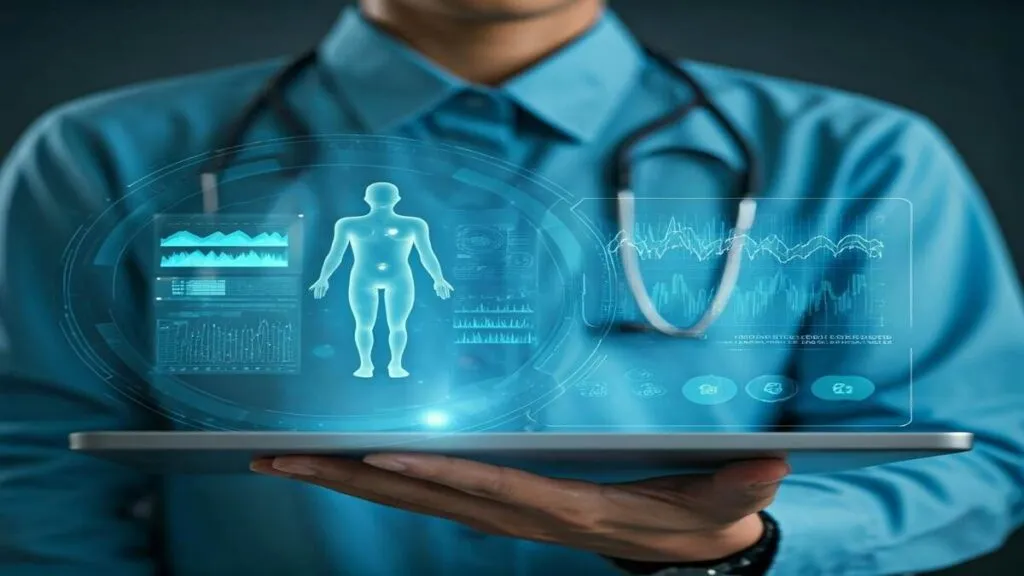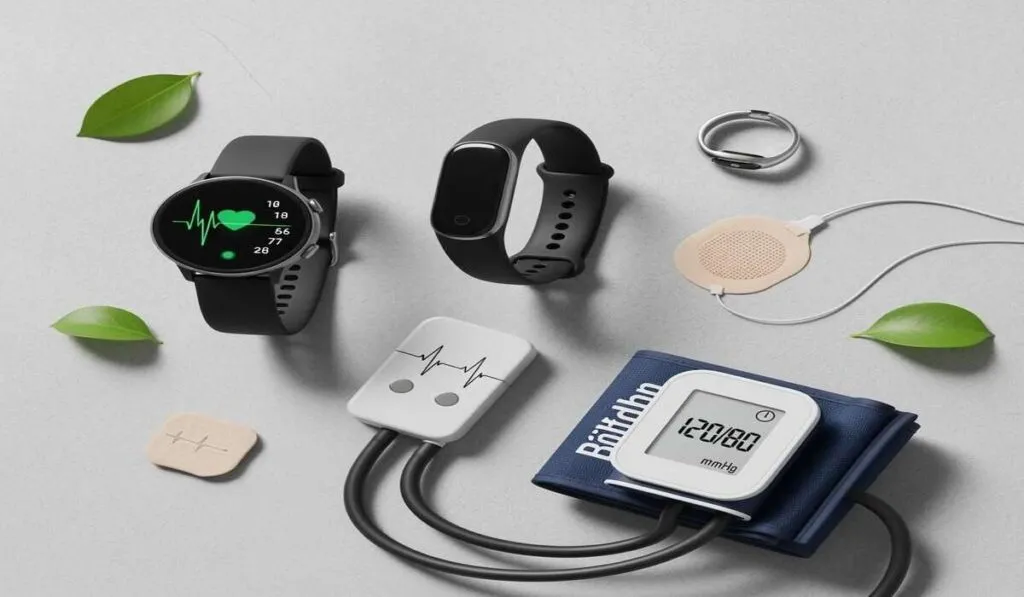
Digital Health Trends in 2025 are revolutionizing the way we approach healthcare—making it smarter, faster, and more personalized than ever before. As we move further into the year, rapid advancements in technology are transforming how we diagnose, treat, and manage health conditions around the world.
Whether you’re a healthcare professional, patient, policymaker, or technology enthusiast, these emerging digital health trends are paving the way for a system that’s more proactive, accessible, and compassionate. In this article, we explore the top 10 digital health trends shaping 2025, showcasing real-world applications and what they mean for your health and the future of care.
Contents
🔟 Top 10 Digital Health Trends in 2025

1. Generative AI Becomes a Trusted Clinical Assistant
AI is no longer just a research tool — it’s becoming a trusted clinical partner in digital health, with advances covered in more detail in our article on AI in Healthcare Diagnosis.
Powered by generative AI models trained on huge amounts of medical data, tools like Google MedLM and OpenAI’s BioGPT help doctors by:
- Accurately summarizing patient histories
- Drafting detailed SOAP notes
- Suggesting possible diagnoses supported by clinical evidence
When hospitals integrate AI with Electronic Health Records (EHR), doctors get real-time decision support that highlights treatment options based on the latest guidelines. Patient-facing chatbots provide reliable answers, easing clinic workload.
Example: A radiologist uses AI to detect subtle anomalies in scans, improving early cancer diagnosis rates.
Why it matters: Clinicians spend less time on paperwork and more on meaningful patient interaction—enhancing both care quality and job satisfaction.
2. Remote Patient Monitoring 2.0 (RPM 2.0)

Wearables and implantable devices are changing the game for people managing chronic conditions. Today’s FDA-approved sensors can continuously track:
- Blood sugar levels for those with diabetes
- Heart rhythms in patients with heart failure
- Breathing patterns in people with COPD
What’s even more powerful? These devices connect to AI-powered dashboards that alert doctors right away when something’s off. Imagine a smart vest that detects early signs of fluid buildup in a heart failure patient—days before symptoms even appear. That kind of early warning can reduce emergency hospital visits by nearly 40%.
In rural or underserved areas, RPM enables continuous, high-quality care without costly hospital stays.
Why it matters: This tech empowers patients to participate actively in their health while improving outcomes and reducing costs.
3. Digital Therapeutics (DTx) Are Prescribed Like Medicine
Digital Therapeutics, or DTx, are more than just health apps—they’re FDA-cleared software tools that have been clinically proven to treat real medical conditions. These digital tools can help:
- People with insomnia through guided Cognitive Behavioral Therapy (like Somryst)
- Those battling depression or anxiety using AI-powered CBT programs
- Individuals at risk of diabetes through behavior change and lifestyle coaching
And here’s the good news: many of these tools are now covered by health insurance, just like prescription meds.
Why it matters: DTx makes therapy more accessible, removing barriers like stigma, distance, and cost by delivering care right to your device.
4. Virtual Care Gets Personal with AI + Wearables
Telemedicine has gone beyond video calls. In 2025, virtual care is a full-on ecosystem powered by AI and wearables. Patients now experience:
Today’s patients can do things like:
- Track their heart rate, oxygen levels, and sleep with a smart ring or skin patch
- Get custom health advice from AI-driven apps—24/7
- Order lab tests from home and have medications delivered within hours
Take this example: A cancer survivor uses a single mobile app to log symptoms, track emotional well-being, and receive tailored recommendations—all synced with their smartwatch. Their care team is always in the loop, even when they’re miles away.
Why it matters: Care becomes proactive and continuous helping catch complications before they worsen.
5. Interoperability and Health Data Ownership Finally Arrive
Not long ago, retrieving your full medical history was like piecing together a puzzle—hospitals, clinics, and labs all held separate parts. In 2025, that puzzle is solved. With the adoption of FHIR (Fast Healthcare Interoperability Resources) and stronger laws protecting patient data, your health records can now travel with you—securely and under your control.
Now, with just a few taps on your phone, you can:
- Access and download your entire medical history
- Share records instantly when you visit a new doctor or specialist
- Keep everything—from lab results to prescriptions and wearable info—in a secure “digital health wallet”
This is especially vital for travelers or patients seeing multiple specialists.
Why it matters: Portable data means personalized, timely care—no more repeated tests or lost records.
6. AI-Powered Drug Discovery and Personalized Medicine

The time from drug concept to clinical trial has drastically shortened thanks to AI simulating molecular interactions. Precision medicine uses:
- Genomic profiling
- Lifestyle data integration
- AI to tailor treatments for cancer, rare diseases, and more
These innovations result in more targeted, effective therapies with fewer side effects.
Why it matters: Personalized medicine brings us closer to real cures, rather than just managing symptoms.
7. Mental Health Tech Moves beyond Talk Therapy
New innovations include:
- Emotion-sensing wearables that detect stress
- AI-powered chatbots like Woebot that check in with you anytime
- Virtual reality tools to treat PTSD, anxiety, or phobias
Why it matters: Mental healthcare is now continuous, stigma-free, and more accessible than ever before.
8. Health Equity Tech: Bridging the Gap in Care
Technology is finally addressing health disparities by:
- Developing AI trained on diverse populations to reduce bias
- Deploying mobile clinics with solar-powered diagnostics in remote regions
- Offering multilingual apps—including Amharic—to increase access
These initiatives work to close long-standing healthcare gaps worldwide.
Why it matters: Everyone deserves quality healthcare, no matter their background or location.
9. Preventive Health Goes Mainstream with Digital Nudges
Apps and wearables now go beyond tracking—they actively promote health by:
- Sending personalized reminders to exercise or hydrate
- Rewarding healthy behavior with incentives
- Using AI to predict and prevent illness
This empowers individuals to maintain wellness and avoid chronic conditions.
Why it matters: Prevention lowers healthcare costs and improves quality of life.
10. Hybrid Hospitals: The Rise of “Click-and-Mortar” Care
Hospitals blend physical and digital services by integrating:
- Robotic disinfection and AI triage tools
- Virtual consultations and online booking
- Smart beds with real-time vital monitoring
This hybrid model increases efficiency, safety, and patient comfort.
Why it matters: Combining tech with human touch provides the best care experience.
Frequently Asked Questions (FAQ)
Q1: Are these technologies accessible worldwide?
Yes, while adoption varies, many digital health solutions are specifically designed for low-resource settings and are being piloted globally.
Q2: Can AI replace doctors?
AI is a powerful tool but not a replacement. It supports clinicians by providing insights, not decisions, as explored in our detailed article on AI in Healthcare Diagnosis. Human judgment remains essential.
Q3: How secure is my health data?
Most platforms comply with international security standards (like HIPAA), giving patients control over what data is shared and with whom.
Q4: Are wearables necessary to benefit from digital health?
Not always. Smartphones often have built-in sensors and apps that provide valuable health insights, making digital health accessible to many.
Digital Health Trends in 2025 aren’t just about new gadgets or futuristic tools — they’re about empowering people like you to live healthier, longer, and more connected lives. Whether you’re using a smartwatch to track your steps or exploring therapy through an app, you’re already part of this healthcare transformation.
So, take a moment to think: What trend would make the biggest difference in your life? 💬 We’d love to hear your thoughts in the comments.
References
- JMIR – Digital Therapeutics in China: Review of Clinical Trials and Market Trends (2025)
- World Economic Forum – AI Transforming Global Health (2025)
- World Health Organization. Global strategy on digital health 2020–2025. Geneva: World Health Organization; 2021.
Disclaimer: This article is for informational purposes only. It is not a substitute for professional medical advice. Always consult a qualified healthcare provider before making health or treatment decisions.
Founder of My Health Tech Talk. He is a health informatics professional, researcher, and graduate assistant with a passion for digital health and innovation, medical tourism and health tips. Learn more about author and his mission on the About Us page

